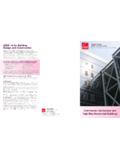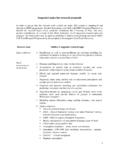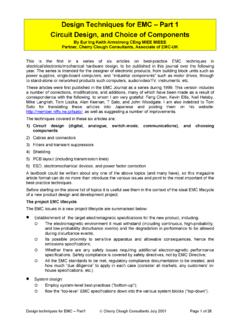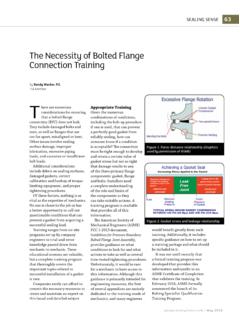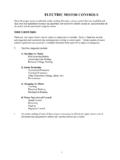Transcription of CRR 100:1996 Safe disposal of vented reacting fluids
1 3s HSE Health G Safety Executive HSE CONTRACT RESEARCH REPORT No. 10011 996 safe disposal OF vented reacting fluids Dr J Singh Hazard Evaluation Laboratory Inc. 50 Moxon Street Barnet Hertfordshire EN5 5TS 3E HSE Health 6 Safety Executive HSE CONTRACT' RESEARCH REPORT No. lOO/l996 safe disposal OF vented reacting fluids Dr J Singh Hazard Evaluation Laboratory Inc. 50 Moxon Street Barnet Hertfordshire EN5 5TS Batch reactor vessels used in many sectors of the chemical industry are frequently protected by a relief valve or rupture disc, which will open in case of overpressure, following for example the loss of coolant. It has been found that in many cases, relief actuation is accompanied by the release of a two-phase mixture of gaslvapour and liquid out of the reactor vessel. The release of large amounts of toxic andlor flammable liquid into the atmosphere poses a serious safety and environmental hazard and as a result companies are under pressure to contain the released chemicals.
2 This report presents the results of a brief study to evaluate the design of disposal equipment downstream of reactor vents, following two-phase relief of an exothermically reacting liquid. The report presents the procedure that must normally be adopted in selecting a disposal unit, the basic equations governing the design and the methodology for experimentally obtaining the data needed. Four different exothermic chemical reactions are presented as examples, illustrating fully the procedures involved This report and the work it describes were jointly funded by the Health and Safety Executive and Hazard Evaluation Laboratory Ltd. Its contents, including any opinions and/or conclusions expressed, are those of the author alone and do not necessarily reflect HSE policy. 0 Crown copyright 1996 Applications for reproduction should be made to HMSO First published 1996 lSBNO717611078 All fights reserved No part of this publication may be reproduced, sforedm a refnevaisystem, or transmitted in any form or by any means (electronic, mechanical, photocopying, recordrog, or olhenvrse) without the poor wrinen permission of the copyrighr owner EXPERIMENTAL DETAILS TEST RESULTS RELIEF SYSTEM DESIGN BASIS disposal SYSTEM: SIMPLE KNOCK-OUT DRUM disposal SYSTEM: PASSIVE QUENCH CONCLUSIONS REFERENCES 7.
3 EXAMPLE 2: METHANOL-ACETIC ANHYDRIDE EXPERIMENTAL DETAILS RESULTS disposal SYSTEM DESIGN BASIS disposal INTO ATMOSPHERIC KNOCK-OUT DRUM DESIGN OF PASSIVE QUENCH DRUM SELECTION OF QUENCH DRUM DESIGN CONCLUSIONS REFERENCES 8 . EXAMPLE 3: NITRATION OF TOLUENE INTRODUCTION OVERVIEW OF MONONITRATION OF TOLUENE EXPERIMENTAL DETAILS TEST RESULTS disposal SYSTEM DESIGN BASIS disposal INTO ATMOSPHERIC KNOCK-OUT DRUM disposal SYSTEM: PASSIVE QUENCH CONCLUSIONS REFERENCES 9 . EXAMPLE 4: H,O, DECOMPOSITION ~. INTRODUCTION EXPERIMENTAL DETAILS TEST RESULT RELIEF SYSTEM DESIGN BASIS DESIGN OF OPEN KNOCK-OUT disposal DRUM DESIGN OF ATMOSPHERIC PRESSURE QUENCH DRUM CONCLUSIONS 1 0 . CONCLUSIONS 1 1. INTRODUCTION NATURE OF PROBLEM The chemical industry uses large quantities of chemicals which may be toxic and/or flammable in various process units (reactors, storage tanks, intermediate drums etc) . If these units become overpressurized for some reason, the common approach is relieve the pressure through a *weaknessf built into the vessel, usually a bursting disc or valve.
4 If the relief device is large enough, the process unit is protected by preventing overpressurization. The sizing of a suitable relief device becomes rather complex when the problem is caused by a runaway reaction. The rate of pressure and temperature rise is often difficult to obtain and relief actuation frequently leads to venting of a two-phase mixture of vapour (or gas) and liquid. The subject of relief for runaway reactions was studied by DIERS (Design Institute for Emergency Relief systemsj in the USA, a project completed in 1984 involving co-operation from many organizations worldwide and costing in the region of $2million for contractor fees alone (Fisher, 1985). As a consequence of the DIERS work, relief sizing for runaway reactions is now quite well understood and safe designs can be completed economically for many types , although scope for further research remains.. , An important conclusion of the DIERS project was the fact that it is necessary to carry out experimental testing in order to obtain the data necessary for relief sizing.)
5 Indeed the basis for a suitable calorimeter was developed as part of the project and commercial devices have followed on from this. The objective of relieving a process unit is simply to prevent damage due to overpressurization. The disposal of the vented fluids is a separate matter and was not studied in the DIERS project. In view of the toxicity and/or flammability of most chemicals handled, safe disposal is of course very important and it is no longer. acceptable to vent directly to the atmosphere without due regard for the environment. OBJECTIVES OF REPORT The present report is concerned with safe disposal of chemicals following emergency relief of runaway reactions, in effect the next step from the DIERS work. It is therefore assumed that readers are familiar with the nature of runaway reactions and the associated hazards, as well as a basic understanding of relief sizing for these incidents particularly two-phase behaviour under relief conditions.
6 In order to put the report in proper perspective, an overview of these topics is presented and relevant references provided. The aim of the report is to allow engineers to develop a process specification suitable for subsequent detailed engineering. The emphasis will be on ensuring that the vented reactants are properly contained, and that the hazard is not simplytransferred from one section of the plant to another. An understanding of the reaction, after relief, is clearly essential if this is to be achieved and therefore the emphasis will be on the use of bench-scale equipment and data analysis and its application to design. This is very similar to the procedures used for relief sizing, following the DIERS project, and indeed similar types Of equipment with some extensions will be used to derive the information. It is important also to be aware of the sort of information that will not be provided in this report. While types of hardware suitable for containment are mentioned, details of specific types of equipment are not provided.
7 The information necessary to complete a detailed mechanical design will not be provided, only the basis for such a design. The report is not intended to be a design guide but rather it is an .overview of the problem and some research into how disposal system design may beapproached. The report will focus on design implications of venting into disposal tanks, either with a view to complete containment or followed by relief into a downstream unit (flare, absorber, incinerator etc) . The use of small scale testing to provide the necessary information and the application of the information will be illustrated with examples. The chemical systems considered in the report are limited to low viscosity liquids. When the viscosity becomes high (say above 100 cp) the flow through a relief pipe can become laminar, invalidating many of the equations presented. Research into high viscosity systems is currently active. RELIEF OF RUNAWAY REACTIONS - OVERVIEW Relief Sizinq for non-reactinq chemicals ( Chemical reactors, storage tanks and most other process vessels are normally fitted with a bursting disc or a relief valve which in the event of accidental overpressurization opens to prevent equipment damage.)
8 The size ( effective orifice diameter) of the relief device has to be selected so that it can vent at a sufficiently high rate to compensate for the rate of pressurization. Sizing involves two broad steps: * determination of the rate of pressure rise * calculation of the vent diameter large enough to cope with the rise. Almost invariably, the pressure rise in process equipment is due to the generation of vapour (or gas). The safe relief sizing criterion is therefore: rate of vapour (or gas) removal 2 rate of vapour (or gas) generation For example, if fluid in a vented vessel undergoes exothermic reaction producing heat at a rate Q (W) then at steady state the rate of vapour generation M (kg/s) is given by: I. where X (J/kg) is the latent heat of vaporization. Limitations of General A~uroach to Ventinq When the above approach is applied to reactive systems, a number of assumptions often breakdown. The relief sizing criteria as expressed by equation ( ) remains valid at all times but equation ( ) may not represent the total amount of vapour/gas being generated.
9 If the reaction involves production of volatile gas for example, the rate is not directly related to the heat of reaction and latent heat. Thus, the gas rate needs to be determined in a different manner. In sizing a vent the rate of vapour (or gas) generation (due to chemical reaction, for example) is normally determined at 'the conditions when the vent opens (or quite close to it). This rate is then used as the basis for vent sizing. Implicit in this is the assumption that cooling by latent heat after the vent opens will prevent any further temperature rise (and hence prevent increase in the rate of pressure rise). This is sometimes valid for reactive system venting but not always. One obvious case where it is not true is if the reaction generates a large quantity of non-condensible gas; venting the gas will produce no cooling. Thus, the temperature will continue to rise, at the same time increasing the reaction rate. The gas rate for which the vent must be sized will obviously be higher than when the relief device first opened.
10 The final assumption which is frequently invalid for reactive systems is that the relief device can be sized to vent pure vapour (or gas). In most cases a two-phase, vapour-liquid froth may have to be vented . The venting of the entrained liquid (in addition to the vapour) produces relatively little reduction in pressure but its presence in the vent line reduces the vapour (or gas) flow. Thus, the relief device sized for pure vapour will be too small for a two-phase mixture; an order of magnitude underestimation in the area is possible. Classification of Runawav Reactions for Ventinq In order to correctly size relief for a runaway reaction, it is necessary first to classify the system according to the types of reaction products and their ability to remove heat during venting. Once this has been done, it is possible to select an appropriate vent sizing equation (Singh, 1990). The same considerations are also very useful in the design of disposal systems.










